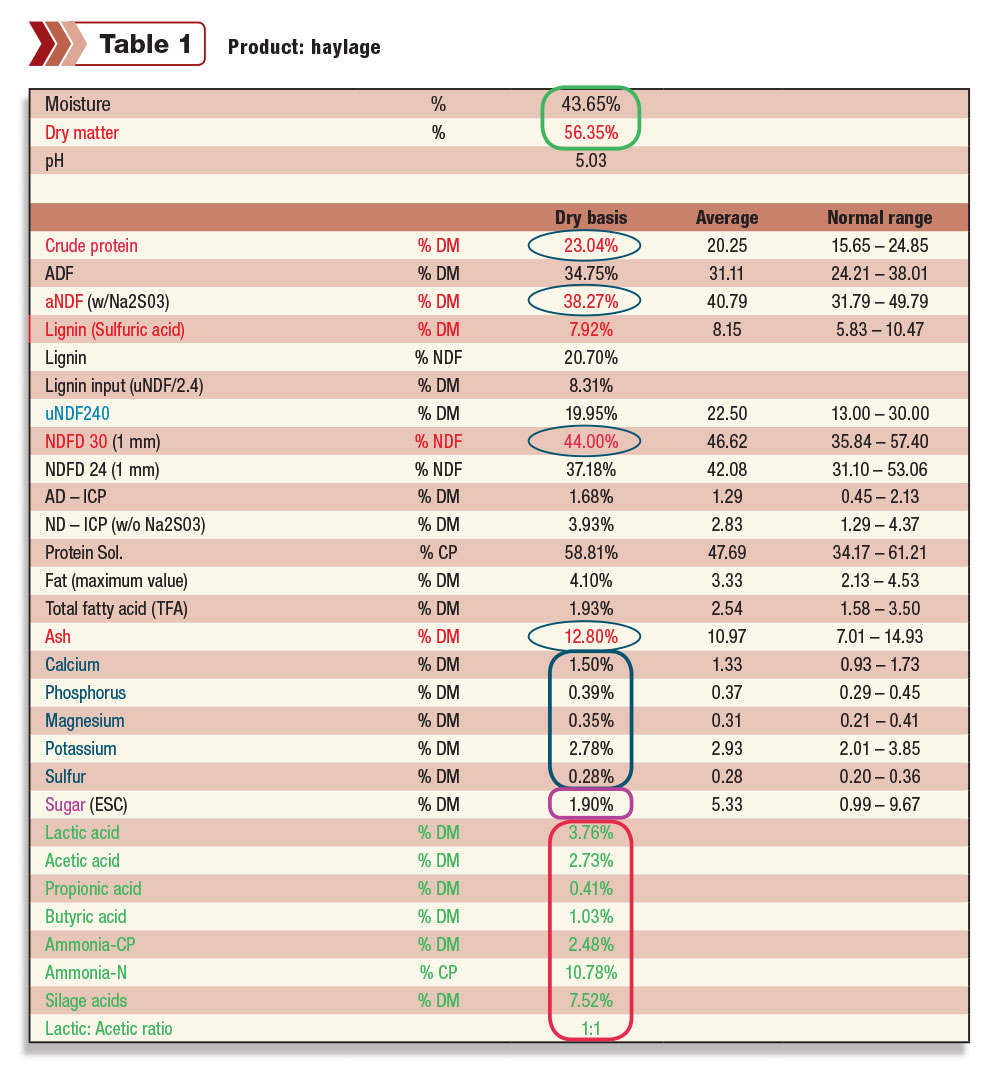Click here or on the image above to view it at full size in a new window. (PDF, 727 KB)
What is dairy-quality hay? The old thumb rule was 20 - 30 - 40: meaning, 20 percent crude protein, 30 percent acid-detergent fiber (ADF) and 40 percent neutral-detergent fiber (NDF).
These numbers would give us a relative feed value (RFV) score of 150. Increasingly, dairy producers and alfalfa growers realize the value of hay or haylage exceeding the traditional target of 150 RFV.
However, we see a wide range in all measurements of quality and many very high in crude protein (CP), digestible NDF (NDFd), RFV and relative feed quality (RFQ).
This would indicate many producers often desire a haylage higher than 150 RFV. This may be due to wanting higher crude protein but may also reflect the ability to get greater intakes and greater milk production from such forage. Today, we are using RFQ.
RFQ is an index for ranking forages based on dry matter intake (DMI) as a percentage of bodyweight (BW) and TDN (total digestible nutrients).
RFQ = (DMI, percentage of BW) x (TDN, percentage of DM).
While the formulae for both DMI and TDN are different between grasses and legumes, NDFd is part of both equations. RFV is based on ADF and NDF, but due to variability in measuring ADF and not using digestibility in the equation, accuracy of forage value has been more difficult to ascertain.
Also, under the RFV system, grasses were typically undervalued due to the fact that lignin was not measured and NDFd not determined.
Compared to alfalfa, grasses will have half as much lignin and be higher in NDF digestibility at the same days of maturity. So even though grasses are higher in NDF, intakes can be comparable.
Numbers of particular interest on a forage test (Table 1) are in red: crude protein percentage, NDF percentage, NDFd percentage, as well as dry matter/moisture and pH.
Too often we focus on the crude protein content of a forage, especially if it is a test for alfalfa, and not the energy and digestibility of a forage.
I think this is because we think in terms of the price of protein supplements and not the amount we need to feed per animal per day. As amount per animal per day, most ruminants need more total dollar amount for energy than for protein.
Crude protein
Crude protein is the total protein in a forage sample. Protein is important to an animal for maintenance, production, growth and also possible growth of a developing calf.
High crude protein is valuable, especially with high supplement prices, but we can place too much emphasis on crude protein alone. Crude protein is further divided into soluble, rumen-degradable, rumen-undegradable and insoluble fractions.
NDF
NDF is a measure of the cell wall contents and is composed of pectin, hemicellulose, cellulose and lignin. These are considered structural carbohydrates. It is the NDF that gives a plant rigidity and support, and provides fiber to a dairy animal.
Pectin, hemicellulose and cellulose are digestible by rumen microbes and provide energy to the ruminant, but lignin is indigestible and can inhibit cellulose digestion.
Other numbers associated with NDF are effective NDF (eNDF), associated with cud-chewing and healthy rumens; dNDF, the amount of dry matter that is digestible NDF; and finally, NDFd, the percentage of NDF that is digestible. NDF has long been negatively associated with intake potential of forage.
Lignin
Lignin is an indigestible phenolic compound that is waterproof glue in plant fiber. Because of its nature, it inhibits cellulose digestion in NDF and thus can lower NDFd and overall energy available from forage.
Ash
Ash is the residue left after combustion of forage. It is the minerals in the forage, silica and any soil residue you picked up in harvest operations, either through the disc mower or rake. This is an important value to know for determining an accurate fiber analysis.
NDFd
NDFd is the percentage of NDF that is potentially digestible. This number is greatly influenced by lignin content. This number is usually determined by 24-hour, 30-hour or 48-hour in vitro incubation or by near-infrared (NIR) based on in vitro equations.
The goal is to have NDFd of more than 50 percent. Due to lower lignin content of grasses, NDFd is typically higher in grasses than alfalfa.
There is a new number being included on forage analyses: uNDF240. It is the number in blue, just above the NDF30 value in Table 1.
It reports how much of the NDF would not be digested after 240 hours in the rumen – or indigestible NDF. Nutritionists are using this value to derive a more accurate rate of NDF digestion. Using the uNDF240 value, users can calculate the D value of a forage. The D value of a forage is the amount of digestible organic matter where:
D= {1-(percentage Ash + percentage uNDF240)}.
A corresponding value could also be total tract NDF digestibility or TTNDF.
The percentage of dry matter gives us an indication of how well the haylage may have been preserved. Optimal dry matter will be 35 to 40 percent for best packing and to have little or no heating.
A pH of 4 or lower is the goal for well-preserved silage. We will see this with corn silage, but with alfalfa haylage, a pH of closer to 5 is more common.
This is due to lower starch content of alfalfa compared to corn silage. If haylage is harvested too dry, there is a greater chance of heating, which can cause protein to be tied up with NDF due to the Maillard reaction. Higher dry matter tends to have greater variation in the bag or pile, which can lead to inaccurate feeding.
The mineral content of the forage is expressed in the dark blue numbers in Table 1. Calcium, phosphorus, potassium, magnesium and sulfur are minerals most often measured. NIR analysis is not as accurate for inorganic materials such as minerals, so for most forages, a wet chemistry analysis of minerals might be a good investment.
Calcium and potassium will likely show the greatest variation from forage to forage. Calcium is higher in legumes compared to grasses. If calcium is over 1 percent and closer to 1.5 percent, it is very likely a legume haylage like alfalfa.
Potassium can also range from 1 percent to more than 3 percent on a DM basis. This can be critical in choosing a dry cow forage.
One last number to look at is for sugar content. As a general rule, hay will be higher in sugar than haylage because sugar feeds the bacteria causing the fermentation.
Also, grass hay cut at the same maturity stage as alfalfa will usually be about twice as high in sugar. Sugar is another component getting increased attention in diet formulations for lactating cow diets. FG

Jim Paulson
Extension Dairy Educator
University of Minnesota











